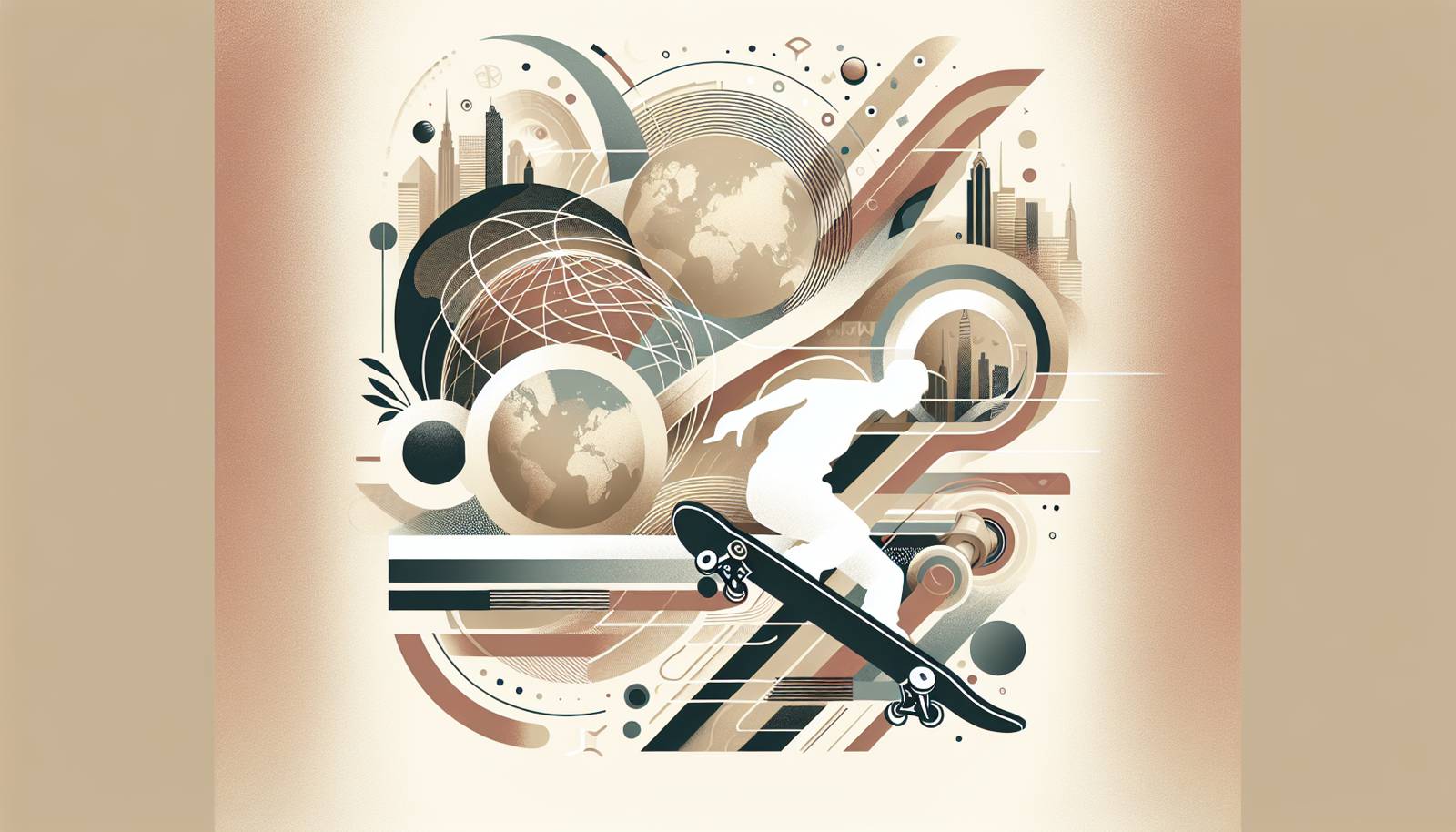
FAQ About The Impact of Skateboarding on Global Culture

How has skateboarding shaped global fashion trends?
Skateboarding has significantly influenced global fashion, particularly streetwear. Iconic skate brands like Vans, Thrasher, and Supreme have transcended the skateboarding community to impact mainstream fashion globally. These brands are known for their casual, urban style, which includes elements like graphic tees, skate shoes, hoodies, and relaxed-fit clothing. This trend has been embraced by high fashion designers who incorporate skate-inspired elements into their collections, thus blurring the lines between streetwear and luxury fashion.

In what ways has skateboarding influenced music?
Skateboarding has a strong connection to music, particularly genres like punk rock, hip-hop, and alternative music. The skateboarding culture of the late 1970s and early 1980s grew alongside punk rock, with bands like the Sex Pistols and Black Flag becoming anthems for skaters. Over time, hip-hop also became closely tied to skateboarding, with artists such as Beastie Boys and Lupe Fiasco featuring skateboarding in their videos and lyrics. Skate videos often feature eclectic soundtracks that have introduced new music to skaters around the world.

How does skateboarding transform public spaces?
Skateboarding transforms public spaces by repurposing urban environments into skating venues. Skaters often use streets, plazas, and other public spaces creatively, which can highlight urban design features and encourage a reimagining of daily environments. Some cities have embraced this by designing skate-friendly spaces and parks, recognizing skateboarding as a legitimate form of recreation that can enhance the vibrancy and inclusivity of public areas.

What role does skateboarding play in fostering youth attitudes and lifestyles?
Skateboarding fosters a sense of independence, creativity, and resilience among youth. It encourages a DIY (do-it-yourself) attitude and pushes individuals to experiment, learn from failures, and develop their unique style. Skateboarding communities often emphasize inclusivity and self-expression, providing a supportive environment where young people can explore their identities and form connections based on shared interests and values.

What is the historical connection between skateboarding and counterculture?
Skateboarding has been historically linked to counterculture since its inception in the 1950s and 60s. It emerged as an alternative sport that went against the structured norms of traditional sports. During the rebellious era of the 1970s, skateboarding found its place alongside movements like punk rock, symbolizing non-conformity and youth rebellion. This spirit of defiance continues today, making skateboarding a symbol of independence and alternative culture.

How has skateboarding impacted the global art scene?
Skateboarding has had a considerable impact on the global art scene. It fosters a creative culture where skaters often engage in various art forms such as photography, filmmaking, painting, and graphic design. Skateboard graphics themselves have become a form of art, with decks often showcasing innovative and provocative designs. Well-known artists like Andy Howell and Mark Gonzales have roots in skating, and this blend of skate and art cultures continues to influence modern artistic expressions.

In which countries has skateboarding had the most impact culturally?
Skateboarding has significantly influenced cultures in countries such as the United States, Japan, Brazil, and Australia. The U.S. is considered the birthplace of modern skateboarding and continues to be a central hub for skate culture. Japan has embraced skateboarding, integrating it with local fashion and arts. Brazil produces numerous world-class skateboarders and has a vibrant skate scene. Australia also has a thriving skateboarding community, known for its competitive spirit and diverse talent.

Why is skateboarding considered a form of self-expression?
Skateboarding is considered a form of self-expression because it allows individuals to develop their unique style and approach to skating. Each skater has their own way of performing tricks and interpreting their environment, making skateboarding a personal and creative pursuit. Additionally, the culture surrounding skateboarding encourages artistic expression through clothing, music, and art, allowing skaters to convey their personalities and emotions.

How has skateboarding changed over the decades?
Over the decades, skateboarding has evolved from a niche pastime to a mainstream sport and cultural phenomenon. In the 1970s, innovations in design and the rise of skateparks popularized the sport. The 1980s and 1990s saw the expansion of skate brands and media coverage, establishing professional skateboarding tours and competitions. Today, skateboarding is part of the Olympic Games, reflecting its global acceptance and recognition as a serious sport.

What are some common misconceptions about skateboarding culture?
Common misconceptions about skateboarding culture include the belief that it is exclusively rebellious or anti-establishment. While skateboarding has roots in counterculture, it encompasses a diverse range of attitudes and lifestyles. Another misconception is that skateboarding is predominantly male, but the number of female skaters has been steadily increasing, with many women achieving high levels of proficiency and visibility in the sport.

How does skateboarding contribute to community building?
Skateboarding contributes to community building by creating inclusive spaces where people of all ages and backgrounds can connect. Skateparks often serve as communal hubs where skaters meet, share tips, and support one another. These spaces foster camaraderie and mutual respect, helping to bridge social divides. Additionally, skateboarding events and competitions often bring communities together, creating local pride and engagement.

How has skateboarding's inclusion in the Olympics affected the sport?
The inclusion of skateboarding in the Olympics has helped elevate the sport's status and legitimacy globally. It has increased mainstream interest and investment, providing skaters with more opportunities for recognition and sponsorship. While some fear the commercial impact on skateboarding's authenticity, others see it as a chance to broaden the sport's appeal and inspire a new generation of skaters.

In what ways does skateboarding promote environmental awareness?
Skateboarding promotes environmental awareness by encouraging outdoor activities that rely on urban spaces rather than new infrastructure. Skaters often become advocates for preserving public spaces and parks, supporting sustainability initiatives. Additionally, some skate brands are committed to producing eco-friendly equipment and clothing, further promoting environmental consciousness within the skateboarding community.

What is the significance of skateboarding in youth subcultures?
Skateboarding holds significant importance in youth subcultures as a symbol of freedom and rebellion. It provides a platform for young people to express their individuality outside mainstream norms. Skateboarding subcultures often emphasize unique aesthetics, music, and attitudes, offering an alternative lifestyle that resonates with youths seeking identity and belonging.

How do skateboarding videos influence the sport and its culture?
Skateboarding videos are crucial in shaping the sport and its culture by showcasing new tricks, styles, and skate spots. They serve as a source of inspiration and information, promoting creativity and progression within the community. In the digital age, online skate videos and platforms like YouTube and Instagram have expanded the reach of skateboarding culture, allowing skaters worldwide to share and discover content.

What impact has skateboarding had on gender roles in sports?
Skateboarding has challenged traditional gender roles in sports by creating space for female and non-binary skaters to gain recognition and respect. With increasing visibility of female skaters and events like "Skate Like a Girl," the sport promotes inclusivity and diversity. Organizations and media are working to spotlight women's contributions, striving to normalize gender equality within the skate community.

What are some global initiatives that support skateboarding culture?
Several global initiatives support skateboarding culture, such as organizations like Skateistan, which empowers youth through skateboarding and education in countries like Afghanistan, Cambodia, and South Africa. The Tony Hawk Foundation also works to develop public skateparks in underserved areas. These initiatives focus on using skateboarding as a tool for social change, education, and community development.

How do skateboarding communities preserve their cultural heritage?
Skateboarding communities preserve their cultural heritage by maintaining a commitment to the sport's roots and values. This includes celebrating pioneering skaters, historic spots, and influential events in skateboarding history. Additionally, skaters often engage in archiving and sharing personal stories, media, and memorabilia that document the evolution of skate culture, thereby preserving its legacy for future generations.

How has technology changed the landscape of skateboarding?
Technology has changed skateboarding by improving equipment, enhancing safety, and connecting skaters worldwide. Advances in materials have made skateboards more durable and versatile. Social media platforms allow skaters to share tricks and connect with a global audience, fostering community growth. Additionally, technology in filming and editing has elevated the production quality of skateboarding media, increasing its appeal and reach.

What challenges do skateboarding communities face today?
Skateboarding communities face challenges such as the commercialization of the sport, which can impact its authenticity and grassroots nature. Access to safe and public skate spaces is another issue, as many cities have limited options for skaters. Moreover, overcoming stereotypes and gaining acceptance remains an ongoing battle, despite the sport's growing popularity and respect on the international stage.
